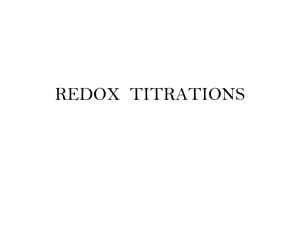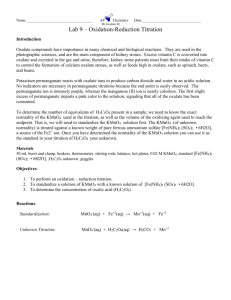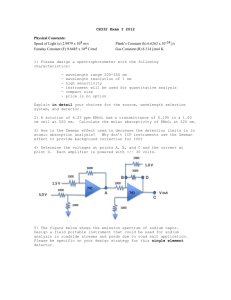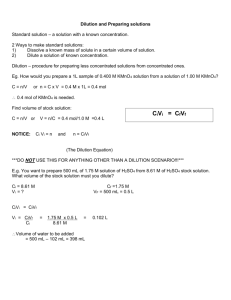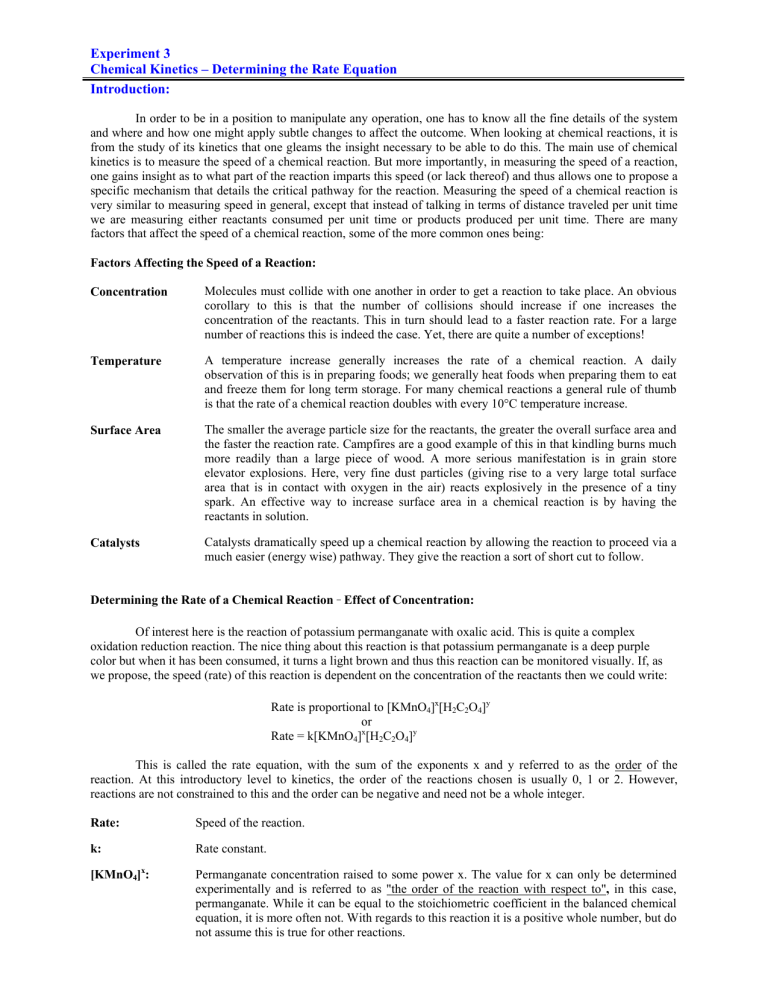
Experiment 3
Chemical Kinetics – Determining the Rate Equation
Introduction:
In order to be in a position to manipulate any operation, one has to know all the fine details of the system
and where and how one might apply subtle changes to affect the outcome. When looking at chemical reactions, it is
from the study of its kinetics that one gleams the insight necessary to be able to do this. The main use of chemical
kinetics is to measure the speed of a chemical reaction. But more importantly, in measuring the speed of a reaction,
one gains insight as to what part of the reaction imparts this speed (or lack thereof) and thus allows one to propose a
specific mechanism that details the critical pathway for the reaction. Measuring the speed of a chemical reaction is
very similar to measuring speed in general, except that instead of talking in terms of distance traveled per unit time
we are measuring either reactants consumed per unit time or products produced per unit time. There are many
factors that affect the speed of a chemical reaction, some of the more common ones being:
Factors Affecting the Speed of a Reaction:
Concentration
Molecules must collide with one another in order to get a reaction to take place. An obvious
corollary to this is that the number of collisions should increase if one increases the
concentration of the reactants. This in turn should lead to a faster reaction rate. For a large
number of reactions this is indeed the case. Yet, there are quite a number of exceptions!
Temperature
A temperature increase generally increases the rate of a chemical reaction. A daily
observation of this is in preparing foods; we generally heat foods when preparing them to eat
and freeze them for long term storage. For many chemical reactions a general rule of thumb
is that the rate of a chemical reaction doubles with every 10°C temperature increase.
Surface Area
The smaller the average particle size for the reactants, the greater the overall surface area and
the faster the reaction rate. Campfires are a good example of this in that kindling burns much
more readily than a large piece of wood. A more serious manifestation is in grain store
elevator explosions. Here, very fine dust particles (giving rise to a very large total surface
area that is in contact with oxygen in the air) reacts explosively in the presence of a tiny
spark. An effective way to increase surface area in a chemical reaction is by having the
reactants in solution.
Catalysts
Catalysts dramatically speed up a chemical reaction by allowing the reaction to proceed via a
much easier (energy wise) pathway. They give the reaction a sort of short cut to follow.
Determining the Rate of a Chemical Reaction _ Effect of Concentration:
Of interest here is the reaction of potassium permanganate with oxalic acid. This is quite a complex
oxidation reduction reaction. The nice thing about this reaction is that potassium permanganate is a deep purple
color but when it has been consumed, it turns a light brown and thus this reaction can be monitored visually. If, as
we propose, the speed (rate) of this reaction is dependent on the concentration of the reactants then we could write:
Rate is proportional to [KMnO4]x[H2C2O4]y
or
Rate = k[KMnO4]x[H2C2O4]y
This is called the rate equation, with the sum of the exponents x and y referred to as the order of the
reaction. At this introductory level to kinetics, the order of the reactions chosen is usually 0, 1 or 2. However,
reactions are not constrained to this and the order can be negative and need not be a whole integer.
Rate:
Speed of the reaction.
k:
Rate constant.
[KMnO4]x:
Permanganate concentration raised to some power x. The value for x can only be determined
experimentally and is referred to as "the order of the reaction with respect to", in this case,
permanganate. While it can be equal to the stoichiometric coefficient in the balanced chemical
equation, it is more often not. With regards to this reaction it is a positive whole number, but do
not assume this is true for other reactions.
[H2C2O4]y:
Oxalic acid concentration raised to some power y. Same criteria as those addressed for the
permanganate.
We thus seem to have quite a few unknowns here.
The Rate _ Method of Initial Rates
In order to determine the speed of the reaction we are going to focus here on the permanganate and simply
equate the speed with the time it takes to use up the permanganate.
Rate = -[KMnO4]/ t = -{[KMnO4]final - [KMnO4]init.]/(tfinal - tinitial)
This simplifies quite remarkably as [KMnO4]final = 0, and by setting tinitial =0.
Rate = -(-[KMnO4]init/tfinal) = [KMnO4]/t
We can then use the method of initial rates to find the exponents x & y. This method involves measuring and
comparing the initial rates of a reaction when different initial concentrations are used. The initial rate for each being
the permanganate concentration divided by time. There is an inherent assumption made here that is not always valid:
we will be measuring tfinal to determine each rate. If you look at the volume of each reagent added for each of the
three experiments you will notice that experiment 2 and 3 are related to 1 in that one of the concentrations is
identical while the other is halved. This helps dramatically with the mathematics involved because if we take the
ratio of the rates of reaction 1 with reaction 2 we get
Rate1 = k[KMnO4]1x[H2C2O4]1y
Rate2 = k[KMnO4]2x[H2C2O4]2y
Rate1= [KMnO4]1/t1
Rate2= [KMnO4]2/t2
Now take the ratio:
Rate1/Rate2 = ([KMnO4]1/[KMnO4]2)x
(remember in these two reactions [H2C2O4]1 = [H2C2O4]2, and thus can be cancelled out)
If you do the experiment carefully, it should be apparent what the value of x should be. It should turn out to be a
whole number. If you want to find its exact value and thus get a feel for the accuracy of the experiment, then the
following general log relationship will be of use:
log10(ax) = xlog10(a)
(a =[ ])
Thus we can determine x. If we now do the same thing for experiments 1 and 3 we can get y. Once we know what x
and y are, then by taking any one of the three experiment we can solve for k, the rate constant. The above may sound
somewhat cumbersome and difficult, but as you will see when you collect the data it is not difficult at all.
Experimental Procedure
Determining the rate of a chemical reaction _ Effect of concentration:
It is also a good idea to perform one trial run to see the color change, which is difficult to describe.
1.
While you are working in pairs, each group of four should set up three burets, one containing KMnO4, one
with H2C2O4 and one with distilled water. Place a label on each. It is difficult to visually differentiate
between water and oxalic acid! Record the molarities of the KMnO4 and H2C2O4.
2.
Into a thoroughly washed and dried Erlenmeyer flask, place the required amount of H2C2O4 and any
distilled water. The amounts are dictated by the experiment that you are doing. You have used burets
sufficient times by now that you should be able to dispense the required amount. If you overshoot, start
again. This lab is very dependent on dispensing the exact quantities.
3.
Into a 15cm test tube place the required amount of KMnO4. Use the same precaution as above.
4.
Add the permanganate to the oxalic acid and commence timing when you have emptied the permanganate
tube. Mix thoroughly by swirling the Erlenmeyer flask and continue swirling until the solution turns a
light yellow/brown color. Stop timing and record the time it actually took for the reaction to take place.
5.
Repeat this with a second and third trial. Take the average of these three as the reaction time.
6.
Repeat steps 3 through 5 for experiments 2 and 3 and determine:
a) The order of the reaction with respect to [KMnO4].
b) The order of the reaction with respect to [H2C2O4].
c) The overall order of the reaction.
d) The rate constant.
e) The rate of the reaction if you were to mix
30mL of H2C2O4
15mL of KMnO4
5mL of H2O
KMnO4
~0.02M
H2C2O4
~0.5M
H2O
Experiment 1
10.0 mL
20.0 mL
0.0 mL
Experiment 2
5.00 mL
20.0 mL
5.00 mL
Experiment 3
10.0 mL
10.0 mL
10.0 mL
